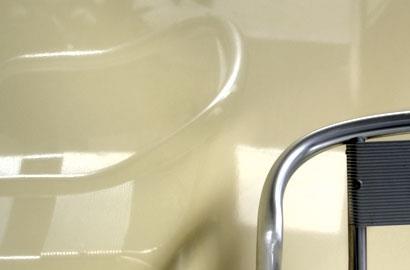The commercial and retail sectors have led interior design, so it’s no surprise the domestic market has turned to them for inspiration on finishes. Peter Caplehorn of Scott Brownrigg looks at the options
Interior finishes in housing are taking on a different look, much of it borrowed from the commercial and retail sectors. What are the materials being employed and what are the practicalities you should be considering?
1. Aesthetics
Aesthetics is king in the finishes world. Use of metals, glass, epoxy, ceramic, and treated timber have all taken hold. Extensive use of these natural finishes is now popular and for good reason – the right material can deliver years of good looks and use. Consider the look you want and specify a material to suit.
Stainless steel is highly popular as a “statement” material, as it is flawless and gleams in light. It is also durable and easily cleaned. On the downside, it’s expensive, prone to dirt and dents and can look clumsy without the right detailing. Fixing should be kept simple; it is better to go for a thicker and more costly grade as thinner sheets will pincushion or distort when installed.
Glass used as a finish is also being employed more widely, whether it is as glass panels, tiles or textured features. Use of glass with a coloured finish on the back provides a durable, glossy and iridescent finish with its own unmistakable character.
Ceramics are available in a vast range of sizes from small modules as part of a mosaic to large panels as part of a wall system. Use of co-ordinated but different modules in the same tile create feature areas and in wet rooms are easy to blend in to a drop in floor level. Be sure to check the slip resistance – a figure of more than 65 on the pendulum test is essential.
Epoxy has been used in flooring for commercial buildings for many years. Use in the domestic market is gradually increasing. It provides a glossy, hard-wearing and smooth finish. Colours can be mixed to create patterns or specific designs. It can be self-levelling in some forms or put on with a trowel and should be laid on to a concrete substrate at between 4mm and 8mm thick. It can provide a durable, seamless and highly attractive floor.
2. Durability
In hardworking areas – kitchens, bathrooms and hallways – the need to wear well and be easy to clean is a priority. One of the lessons learned from commercial and retail buildings is to avoid finishes that discolour easily. Some bright or dark coloured tiles and finishes will discolour with cleaning. Before specifying, check with samples or, for important areas, try to visit an installation that has been in use for several years. Grouting in particular can discolour easily. Use epoxy grout and if possible ensure it is installed with a smooth finish. This avoids the build-up of dirt that will spoil the crisp lines when new. Durable finishes are also good value for money and are sustainable.
3. Sustainability
In the context of finishes, this means considering going behind the advertising gloss and checking the product’s parentage. Check the sourcing, the embedded energy, the processes used to create the finish.
Often there are difficult issues to determine but manufacturers are responding to pressure to provide this information and be more transparent. If you cannot get clarity, try another product and if they are better also tell the original supplier – hopefully they will raise their game.
It is relatively easy to check if timber is coming from a managed source. Although Forest Stewardship Council and Programme for the Endorsement of Forest Certification schemes can be criticised, they are a start and are establishing a trend towards identifying ethically sourced materials. Sourcing of other materials is becoming more and more important to clients – natural stone slates come into this category.
It is possible to set out the sustainable options and present the client with a clear choice. Often the more sustainable options are actually a wiser choice – ensuring a longer life, less maintenance or both.
4. Fit for purpose
In the desire to use materials in innovative and exciting ways, there always has to be a reality check. Sometimes materials are used beyond their capabilities and consequently fail badly. Designers should always balance their enthusiasm for innovation against the need for a sensible result.
Always check the operating limits of a material. For example, can you use it in wet, damp or only dry areas? What movement does it have under humidity and temperature changes? Does it change with age? Many clients are disappointed with the appearance of finishes, either because they change character or simple because they’re not up to the job. Again, look at installed examples.
5. Fixings
Any finish is only as good as the substrate it is fixed to and the way in which it is detailed. Lavish finishes can be ruined by inappropriate fixings or a bad substrate. In general, substrates should offer uniform, stable and appropriate backing for the finish, with the fixing carefully chosen to match. Any joints need to be correctly spaced to allow for thermal movement, cleaning and to ensure the finish is held firm.
Finishes rely on a range of backings. These can be as simple as a base to glue them to, in which case care must be taken to make sure it is the same quality or better than the expected finish. If a framing system is used where the finish will be fixed at various centres, the accuracy of setting out is paramount. Fixing centres must also be chosen to provide support but not pitch or distort the finish.




























No comments yet